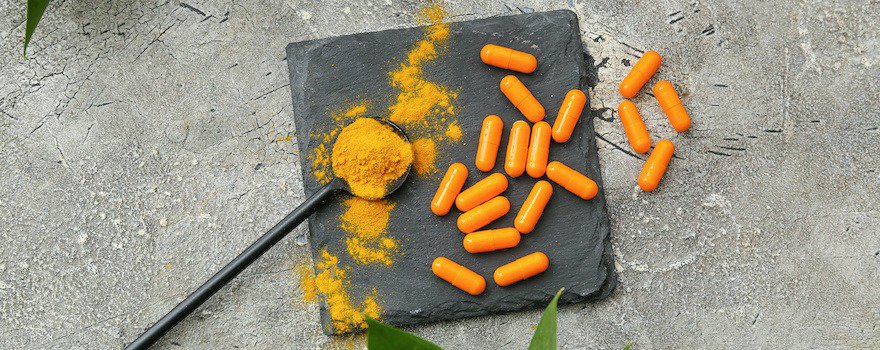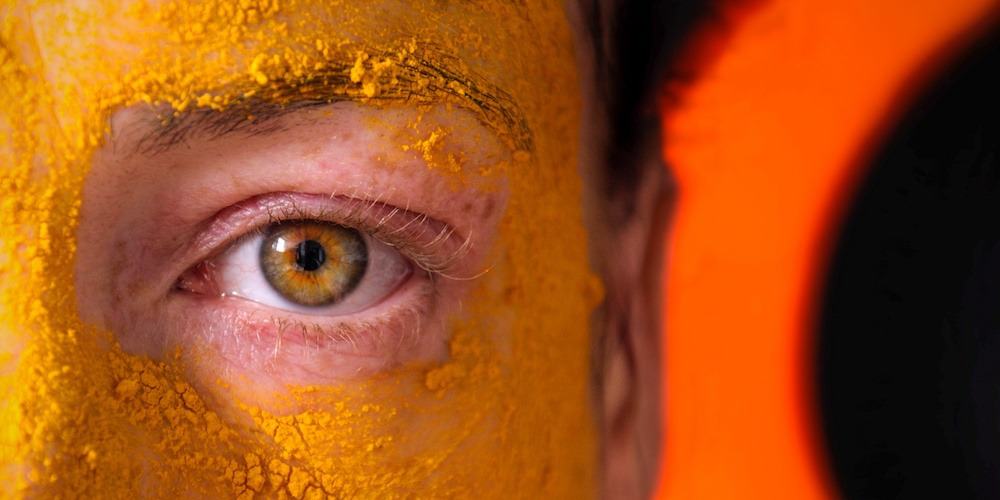What Is Turmeric?
Turmeric is a plant cultivated for its rhizome. In cooking, it can be consumed fresh or used in powdered form as a spice. It is also recognized for its medicinal properties, notably in traditional Ayurvedic medicine.
Its active ingredient is called “curcumin.” This yellow-orange pigment has anti-inflammatory, antioxidant, and detoxifying effects.
It is also credited with beneficial effects on the nervous and cardiovascular systems.
Read also | How to Choose the Best Curcumin?
The benefits of turmeric are also interesting for the skin. Indeed, it has healing, soothing, antibacterial, and anti-inflammatory properties. It can be taken as a dietary supplement or applied directly to the skin, as a mask or poultice.

Its Benefits for the Skin
It Eliminates Toxins
Turmeric is among the best foods to protect and cleanse the liver. As shown by this study, it is an excellent natural detoxifier that helps eliminate toxins from the body: residues of heavy metals, pesticides, etc.
Their accumulation promotes the appearance of blemishes (pimples, blackheads…) and skin diseases like eczema or psoriasis. Dull and tired-looking skin can also reflect a body overloaded with toxins.
By stimulating bile functions and bile production, turmeric cleanses, purifies, and frees the liver from its toxins. It thus contributes to more beautiful and healthier skin.
It Promotes Healing
Other benefits of turmeric for the skin: curcumin supports and accelerates the wound healing process. Cuts, scrapes, burns, acne scars… Both topical and internal uses are beneficial.
It promotes skin regeneration and cell proliferation (development of new cells). Additionally, it increases the synthesis of collagen at the wound site. Finally, it raises levels of superoxide dismutase (SOD). This antioxidant enzyme promotes wound healing and softens scar tissue.
During this study, wounds treated with curcumin (external use) healed much more quickly.
It Soothes Skin Discomfort
Thanks to curcumin’s soothing action, turmeric reduces skin discomforts. Thus, it relieves irritations, itching, tightness, and redness. Applied as a mask directly on the skin, it also soothes sunburn.
Turmeric also contains zinc (4.35 mg/100g) which calms itching and minor skin and scalp irritations.
This study shows that it improves symptoms of psoriasis such as itching and burning sensations.
It Fights Against Bacteria
A natural antibacterial, it fights against certain bacteria responsible for skin diseases like Cutibacterium acnes. During this study, it showed significant effects in the treatment of psoriasis and acne.
Moreover, curcumin has a bacteriostatic effect, meaning it slows down the proliferation and growth of bacteria.
It Reduces Skin Inflammation
A final benefit of turmeric for the skin, and a significant one. Many dermatological diseases are linked to inflammation: acne, dermatitis, rosacea… However, curcumin is capable of regulating the inflammatory process and thus reducing skin inflammation. To do this, it inhibits the production of pro-inflammatory cytokines like IL-6.
This study highlights the potential of curcumin in the treatment of inflammatory skin diseases.

How to Use Turmeric for the Skin?
As a Dietary Supplement
Turmeric as a dietary supplement is available in the form of capsules, tablets, or powder.
Some products combine curcumin with piperine, derived from black pepper. As demonstrated by this study, piperine allows for better absorption of curcumin in the body (up to 20 times more). However, other studies show limited effectiveness.
Choosing a curcumin/piperine supplement is not mandatory but offers better bioavailability.
Curcumin should also be in a free or bioactive form.
Finally, choose a product adequately standardized in curcuminoids and curcumin, with natural composition and without controversial excipients.
Read also | The best supplements for skin according to a pharmacist
For external use
For external use, turmeric serves as an excellent natural beauty treatment. The fresh rhizome and powder can be used to prepare homemade masks and poultices.
You can, for example, create an anti-acne turmeric mask by mixing:
- 1 teaspoon of turmeric powder
- 1 teaspoon of yogurt
- ½ teaspoon of lemon juice
Mix all ingredients until you obtain a homogeneous consistency. Apply to the face and neck, let sit for about 20 minutes, then rinse off.
To avoid potential skin reactions, perform a patch test on the inside of your elbow before applying the mask.



